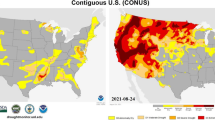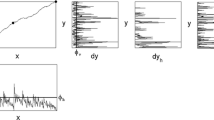Abstract
A deterministic geometric approach, the fractal–multifractal (FM) method, already found useful in modeling storm events, is adapted here in order to encode, for the first time, highly intermittent daily rainfall records gathered over a water year and containing many days of zero rain. Through application to data sets gathered at Laikakota in Bolivia and Tinkham in Washington, USA, it is demonstrated that the modified FM approach can represent erratic rainfall records faithfully, while using only a few FM parameters. It is shown that the modified FM approach, by capturing the rain accumulated over the season, ends up preserving other statistical attributes as well as the overall “texture” of the records, leading to FM sets that are indistinguishable from observed sets and certainly within the limits of accuracy of measured rainfall. This fact is further corroborated comparing 20 consecutive years at Laikakota and a modified FM representation, via common statistical qualifiers, such as histogram, entropy function, and inter-arrival times.













Similar content being viewed by others
Abbreviations
- RMSEAR:
-
Root mean square error in accumulated rainfall (observed vs. FM fitted)
- MAXEAR:
-
Maximum error in accumulated rainfall (observed vs. fitted)
- NSR7:
-
Nash–Sutcliffe statistic between observed rainfall at the weekly scale (observed vs. fitted)
- NSACR:
-
Nash–Sutcliffe statistic between rainfall autocorrelations (observed vs. fitted)
- AL0:
-
Lag where autocorrelation reaches zero for the first time
- NSHR:
-
Nash–Sutcliffe statistic between rainfall histograms (observed vs. fitted)
- PZMR:
-
Percent of zeros matched between observed and fitted rainfalls
- PF90:
-
Percent histogram mass in fitted records corresponding to 90 % in observed data
- NSER:
-
Nash–Sutcliffe statistic between rainfall entropies (observed vs. fitted)
References
Barnsley MF (1988) Fractals everywhere. Academic Press, San Diego
Cortis A, Puente CE, Sivakumar B (2009) Nonlinear extensions of a fractal–multifractal approach for environmental modeling. Stoch Environ Res Risk Assess 23(7):897–906
Cortis A, Puente CE, Sivakumar B (2010) Encoding hydrologic information via a fractal geometric approach and its extensions. Stoch Environ Res Risk Assess 24(5):625–632
Cortis A, Puente CE, Huang HH, Maskey ML, Sivakumar B, Obregón N (2013) A physical interpretation of the deterministic fractal–multifractal method as a realization of a generalized multiplicative cascade. Stoch Environ Res Risk Assess 28(6):1421–1429
Feder J (1988) Fractals. Plenum Press, New York
Fernández Martínez JL, García Gonzalo E, Fernández Álvarez JP, Kuzma HA, Menéndez Pérez CO (2010) PSO: a powerful algorithm to solve geophysical inverse problems: application to a 1D-DC resistivity case. J Appl Geophys 71(1):13–25
Gupta VK, Waymire E (1990) Multiscaling properties of spatial rainfall and river flow distributions. J Geophys Res 95(D3):1999–2009
Hill MC, Tiedeman CR (2007) Effective groundwater model calibration: with analysis of data, sensitivities, predictions and uncertainty. John Wiley & Sons Inc, Hoboken
Huang HH, Puente CE, Cortis A, Sivakumar B (2012) Closing the loop with fractal interpolating functions for geophysical encoding. Fractals 20(3–4):261–270
Huang HH, Puente CE, Cortis A, Fernández Martínez JL (2013) An effective inversion strategy for fractal–multifractal encoding of a storm in Boston. J Hydrol 496:205–216
Jayawardena AW, Lai F (1994) Analysis and prediction of chaos in rainfall and stream flow time series. J Hydrol 153:23–52
Jin YH, Kawamura A, Jinno K, Berndtsson R (2005) Nonlinear multivariate analysis of SOI and local precipitation and temperature. Nonlinear Process Geophys 12:67–74
Jothiprakash V, Fathima TA (2013) Chaotic analysis of daily rainfall series in Koyna reservoir catchment area, India. Stoch Environ Res Risk Assess 27(6):1371–1381
Kennedy J, Eberhart RC (1995) Particle swarm optimization. Proceedings of the IEEE international joint conference on neural networks. IEEE Service Center, Piscataway, pp 1942–1948
Kim HS, Lee KH, Kyoung MS, Sivakumar B, Lee ET (2009) Measuring nonlinear dependence in hydrologic time series. Stoch Environ Res Risk Assess 23:907–916
Kumar P, Foufoula-Georgiou E (1993) A multicomponent decomposition of spatial rainfall fields. Segregation of large and small scale features using wavelet transform. Water Resour Res 29(8):2515–2532
Labat D (2008) Wavelet analysis of annual discharge records of the world’s largest rivers. Adv Water Resour 31:109–117
Labat D, Ababou R, Mangin A (2000) Rainfall–runoff relations for karstic springs—part II: continuous wavelet and discrete orthogonal multiresolution analyses. J Hydrol 238:149–178
Lanza LG, Vuerich E (2009) The WMO field intercomparison of rain intensity gauges. Atmos Res 94(4):534–543
Lorenz EN (1963) Deterministic nonperiodic flow. J Atmos Sci 20:130–141
Lovejoy S, Schertzer D (1990) Multifractals, universality classes and satellite and radar measurements of cloud and rain fields. J Geophys Res 95(3):2021–2034
Lovejoy S, Schertzer D (2013) The weather and climate: emergent laws and multifractal cascades. Cambridge University Press, Cambridge
Mandelbrot BB (1982) The fractal geometry of nature. Freeman, San Francisco
Mandelbrot BB (1989) Multifractal measures especially for the geophysicist. In: Scholz CH, Mandelbrot MM (eds) Fractals in geophysics. Birkhanser Verlag, Basel, pp 1–42
Meneveau C, Sreenivasan KR (1987) Simple multifractal cascade model for fully developed turbulence. Phys Rev Lett 59:1424–1427
Mishra AK, Özger M, Singh VP (2011) Wet and dry spell analysis of global climate model-generated precipitation using power laws and wavelet transforms. Stoch Environ Res Risk Assess 25:517–535
Nash J, Sutcliffe JV (1970) River flow forecasting through conceptual models, part I—a discussion of principles. J Hydrol 10(3):282–290
Niu J, Chen J (2010) Terrestrial hydrological features of the Pearl River basin in South China. J Hydro-Environ Res 4:279–288
Obregón N, Puente CE, Sivakumar B (2002a) Modeling high resolution rain rates via a deterministic fractal–multifractal approach. Fractals 10(3):387–394
Obregón N, Puente CE, Sivakumar B (2002b) A deterministic geometric representation of temporal rainfall. Sensitivity analysis for a storm in Boston. J Hydrol 269(3–4):224–235
Puente CE (1996) A new approach to hydrologic modelling: derived distribution revisited. J Hydrol 187:65–80
Puente CE, Obregón N (1996) A deterministic representation of temporal rainfall: result for a storm in Boston. Water Resour Res 32(9):2825–2839
Puente CE, Sivakumar B (2007) Modeling hydrologic complexity: a case for geometric determinism. Hydrol Earth Syst Sci 11:721–724
Puente CE, Robayo O, Díaz MC, Sivakumar B (2001a) A fractal–multifractal approach to groundwater contamination. 1. Modeling conservative tracers at the Borden site. Stoch Environ Res Risk Assess 15(5):357–371
Puente CE, Robayo O, Sivakumar B (2001b) A fractal–multifractal approach to groundwater contamination. 2. Predicting conservative tracers at the Borden site. Stoch Environ Res Risk Assess 5(5):372–383
Rodriguez-Iturbe I (1986) Scale of fluctuation of rainfall models. Water Resour Res 22(9):15S–37S
Rodrıguez-Iturbe I, De Power FB, Sharifi MB, Georgakakos KP (1989) Chaos in rainfall. Water Resour Res 25(7):1667–1675
Sivakumar B (2000) Chaos theory in hydrology: important issues and interpretations. J Hydrol 227(1–4):1–20
Sivakumar B (2004) Chaos theory in geophysics: past, present and future. Chaos, Solitons Fractals 19(2):441–462
Sivakumar B (2009) Nonlinear dynamics and chaos in hydrologic systems: latest developments and a look forward. Stoch Environ Res Risk Assess 23:1027–1036
Sivakumar B, Singh VP (2012) Hydrologic system complexity and nonlinear dynamic concepts for a catchment classification framework. Hydrol Earth Syst Sci 16:4119–4131
Sivakumar B, Sorooshian S, Gupta HV, Gao X (2001) A chaotic approach to rainfall disaggregation. Water Resour Res 37(1):61–72
Sivakumar B, Woldemeskel FM, Puente CE (2014) Nonlinear analysis of rainfall variability in Australia. Stoch Environ Res Risk Assess 28(1):17–27
Tessier Y, Lovejoy S, Schertzer D (1993) Universal multifractals: theory and observations for rain and clouds. J Appl Meteorol 32:223–250
Acknowledgments
The research leading to this article was supported by a JASTRO Award provided to the first author by the University of California, Davis. We are thankful to Ministerio de Medio Ambiente y Agua, Bolivia for providing rainfall records gathered at Laikakota and also to the team of National Resource Conservation Service for the availability of rainfall records in its web portal. Bellie Sivakumar acknowledges the financial support from the Australian Research Council (ARC) through the Future Fellowship grant awarded to him (FT110100328). The thoughtful comments from anonymous reviewers are gratefully acknowledged, as they resulted in an improved manuscript, both technically and in presentation. Those are gratefully acknowledged.
Author information
Authors and Affiliations
Corresponding author
Appendix 1: FM parameters for rainfall encoding
Appendix 1: FM parameters for rainfall encoding
Figure | Maps | X1 | X2 | X3 | X4 | Y1 | Y2 | Y3 | Y4 | Y5 | d1 | d2 | d3 | p1 (%) | p2 (%) | p3 (%) | \(\phi_{\varvec{v}}\) (%) |
|---|---|---|---|---|---|---|---|---|---|---|---|---|---|---|---|---|---|
3A | 3 | 0.525 | 0.704 | 0.390 | 0.907 | −4.583 | 2.478 | −1.907 | 1.185 | −0.911 | 0.116 | 0.455 | −0.573 | 24.4 | 25.5 | 50.1 | 30.8 |
3B | 2 | 0.033 | 0.327 | 1 | − | 2.737 | −2.758 | −1.417 | – | – | −0.136 | −0.715 | – | 22.7 | 77.3 | – | 26.3 |
3C | 3 | 0.367 | 0.630 | 0.443 | 0.958 | 1.578 | 0.575 | −1.903 | −2.002 | 1 | −0.358 | −0.250 | 0.128 | 43.8 | 17.7 | 38.5 | 16.1 |
5A | 2 | 0.068 | 0.584 | 1 | – | 4.951 | −0.249 | 3.709 | – | – | 0.536 | 0.288 | – | 42.3 | 57.7 | – | 28.7 |
5B | 3 | 0.759 | 0.256 | 0.316 | 0.947 | 0.526 | −2.137 | 1.222 | −3.538 | 0 | −0.692 | 0.127 | −0.003 | 31.4 | 39.4 | 29.2 | 5.7 |
5C | 3 | 0.000 | 0.613 | 0.271 | 0.374 | 4.992 | 2.287 | −2.847 | −1.669 | 5 | 0.143 | 0.173 | 0.010 | 43.0 | 32.4 | 24.6 | 3.3 |
7A | 3 | 0.277 | 0.545 | 0.589 | 0.988 | −2.688 | −2.431 | 1.697 | 0.015 | 5 | 0.184 | −0.374 | −0.312 | 32.9 | 38.7 | 28.4 | 12.1 |
7B | 3 | 0.117 | 0.463 | 0.149 | 0.385 | 4.643 | 2.531 | 0.798 | −0.915 | 2.023 | −0.316 | −0.530 | −0.255 | 43.2 | 20.5 | 36.3 | 19.9 |
7C | 3 | 0.101 | 0.000 | 0.760 | 0.566 | −0.756 | −0.570 | −2.026 | −2.206 | 5 | −0.590 | −0.191 | 0.269 | 37.7 | 13.1 | 49.2 | 14.5 |
8A | 3 | 0.379 | 0.996 | 0.802 | 0.482 | 4.023 | −3.796 | 4.909 | 0.057 | 5 | −0.737 | −0.239 | 0.461 | 64.8 | 32.8 | 2.4 | 27.7 |
8B | 3 | 0.428 | 0.434 | 1 | – | −0.368 | −3.998 | 3.577 | – | – | −0.069 | 0.341 | −0.325 | 25.2 | 30.7 | 44.1 | 10.3 |
8C | 3 | 0.003 | 1.000 | 0.366 | 0.327 | −5.000 | 4.861 | 0.635 | −3.766 | 0 | 0.182 | −0.456 | 0.116 | 25.2 | 44.5 | 30.3 | 16.1 |
Rights and permissions
About this article
Cite this article
Maskey, M.L., Puente, C.E., Sivakumar, B. et al. Encoding daily rainfall records via adaptations of the fractal multifractal method. Stoch Environ Res Risk Assess 30, 1917–1931 (2016). https://doi.org/10.1007/s00477-015-1201-7
Published:
Issue Date:
DOI: https://doi.org/10.1007/s00477-015-1201-7




